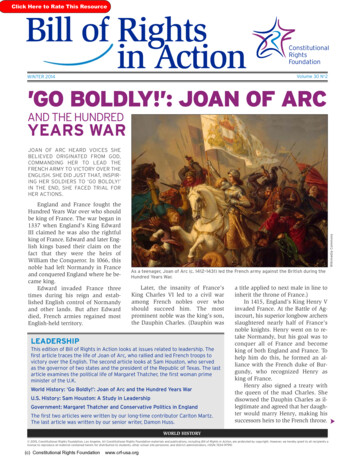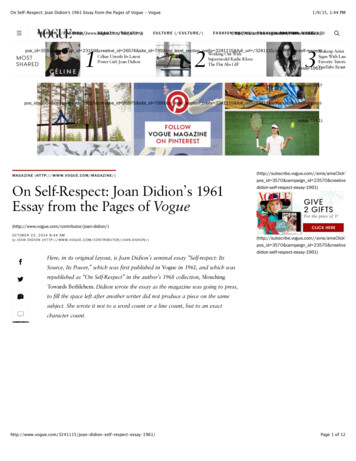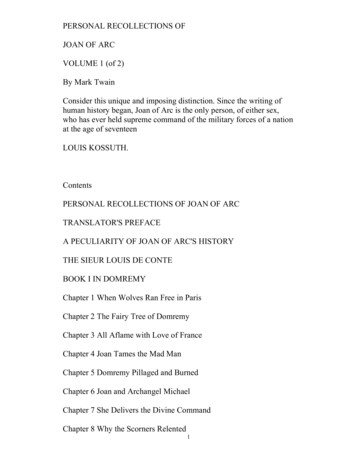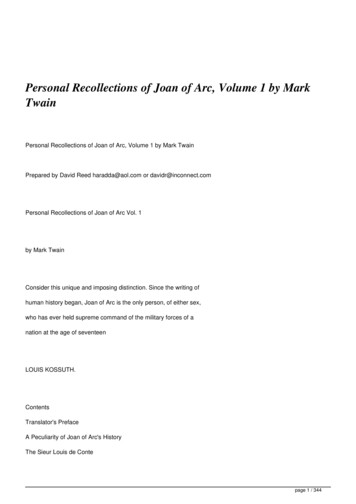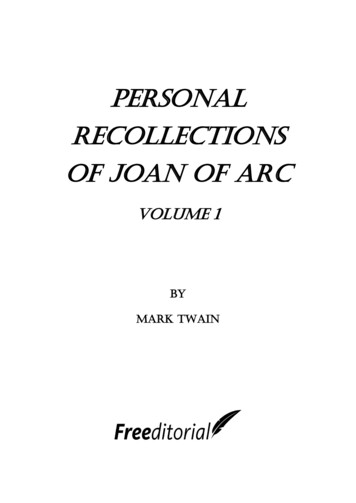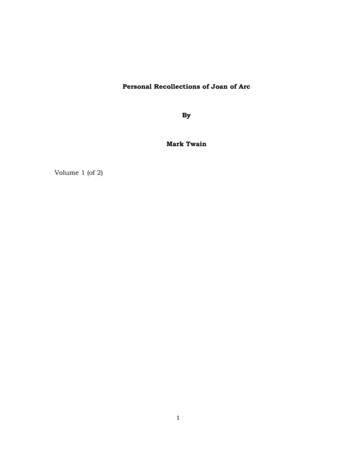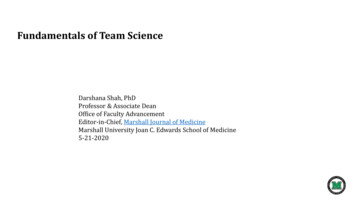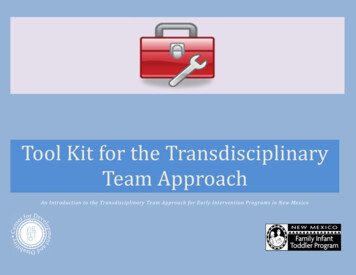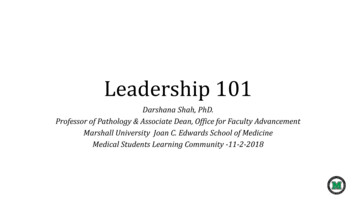
Transcription
Leadership 101Darshana Shah, PhD.Professor of Pathology & Associate Dean, Office for Faculty AdvancementMarshall University Joan C. Edwards School of MedicineMedical Students Learning Community -11-2-2018
What is leadership?
Leadership Power of position or Title Can come from anywhere There is no perfect recipes
Leadership frameworkLeadershipModels Based on values ormoral position Expressed throughideas and words May underpin amodel or style Like a compass orcodeLeadershipPhilosophies Teach us how to be effectiveleaders Contain/Enable processes andmeasureable standards Supported by diagrams andgraphsLeadershipStyles Focus on leadershipbehaviors Influenced byleader’s personality Like a tool in theleadership modelstoolbox
Frequently Cited Models Rubin, Plovnick, and Fry (1977) “Task oriented TeamDevelopment” Katzenbach and Smith (1993) “The Wisdom of Teams” LaFasto and Larson (2001) “When the Teams WorkBest” Hackman (2002) “Leading Teams” Patrick Lencioni (2005) “The five Dysfunctions of aTeam”
The GRPI Model of Team EffectivenessRubin, Plovnick, and Fry Model (1977)Katzenbach and Smith idualWork flowInterpersonalRelationship Trust,collaboration, communication,Sensitivity and flexibilityRubin, I. M., Plovnick, M. S., & Fry, R. E. (1977).Task oriented team development.SpecificGoalsCollectivework productsCommitmentCommonApproachPersonalgrowthThe Wisdom of Teams by J R. Katzenbach & D K Smith
Five Dysfunctions of a TeamModel—Lencioni (2005)Five Dynamics of Teamwork andCollaboration Model—LaFastoand Larson (2001)Inattention toResults Status egoOrganization EnvironmentAvoidance ofTeam LeadershipLow standardACCOUNTABILITYTeam Problem SolvingLack ofTeam RelationshipsAmbiguityCOMMITMENTTeam MemberFear ofArtificial harmonyCONFLICTLaFasto, F., & Larson, C. (2001). When teams work best: 6000 teammembers and leaders tell what it takes to succeed. Thousand Oaks, CA:Sage.Absence ofTRUSTLencioni, P. (2002). The five dysfunctions of a team: A leadership fable. SanFrancisco: Jossey-Bass.Invulnerability
COLLABORATION & TEAM SCIENCETRUSTVISIONSELF-AWARENESS AND EMOTIONAL INTELLIGENCELEADERSHIPMENTORINGTEAM EVOLUTION AND DYNAMICSCOMMUNICATIONCONFLICT AND DISAGREEMENTNAVIGATING AND LEVERAGING NETWORKS ANDSYSTEMSNational Cancer InstituteCollaboration and Team Science: A GuideL. Michelle Bennett. Et. Al. 2018
Significant Similarities Common purpose about what needs to beaccomplished or team goal(s) Trust Trust in Truthful Communication Trust in Actions Trust Inside the Team Teaming skills Resource ManagementTeam LearningDecision MakingConflict ResolutionTeam AtmosphereManaging Process
Roadblocks to SuccessfulTEAM DynamicsTeaming Culturecurious, passionate,empathicTask structure,LeadershipCompetencies,Personality types
A Brief History of Personality Tests First used by the U.S. Army during World war I to try to predictwhich soldiers would suffer from “shell shock,” Today Personality testing 500 million industry, with an annualgrowth rate estimated at 10% to 15%. (Millions of workers take assessments each year as part ofpersonnel selection, to improve collaboration and teamwork, andto identify satisfying career paths)
Winning ColorsEach color is reflective of your personality.You will identify a primary and a secondary color.These are your preferred styles.The colors you do not choose will have some characteristics that arerepresentative of you; however, it is not your preferred style.Winning Colors is valuable for improving your effectiveness inworking with others.www.winningcolors.com
What Color Are You? Look at the pictures on each of the cardsPlace the cards in order with the one most like you at 12 o’clock, next at3, then 6 then 9.Now read the back of the cards. Do you still rank them in the sameorder? If not rearrange until your strongest trait is at 12 o’clock andthen 3, 6, 9www.winningcolors.com
In a nutshell Green – “Why?”Brown – “Be Prepared”Blue – “How does that make you feel?”Orange – “Just do it”
How is this Applicable to you? We all have a part of each personality Understanding our personality and being able to notewhen we need to use more of one or another helps uscommunicate and work together Learning to pick up on others personalities can help usutilize their strengths on a team and understand theirway of work and interaction. It can also help avoid or work through conflict on ateam Build a team with not just the skills but personalitiestoo.
Everyone has some of each color.We each have our strengths and our weaknesses and canlearn to use different traits in different teams and situations.Try to play to each others strengths and consider howothers approach ideas, projects, and communication.Use this information to become a better communicator andteam player.
Exercise # 1
Team Leadership Team Problem Solving Team Relationships Team Member LaFasto, F., & Larson, C. (2001). When teams work best: 6000 team members and leaders tell what it takes to succeed. Thousand Oaks, CA: Sage. Lencioni, P. (2002). The five dysfunctions of a team: A leadership fable. San Francisco: Jossey-Bass. Status ego Low standard Ambiguity
